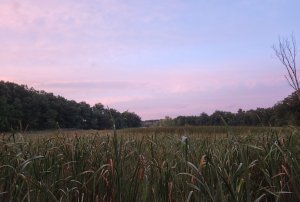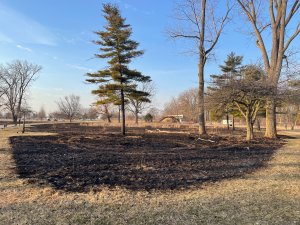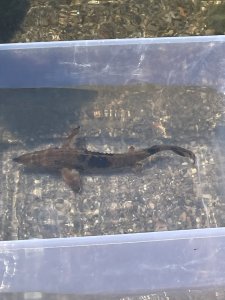Wetlands, Wildlife, and Shore Development: Coping with our ever-changing landscape.
June 21, 2023
by Ali Groulx, Park Interpreter
Imagine you are looking out onto a glossy, still lake on a crisp late-spring morning. As you gaze across the water, you can see what lies beyond the lake… what is the first thing that you imagine seeing? Depending on where you are, you may notice cattails reaching for the sky, the light green hue of freshly sprouted trees, maybe even a sprawling wetland that seamlessly transitions water into land; a safe haven for the little birds you notice flittering around. Or, the first thing you imagined may have been tall, tiered lake-front houses, each hosting a deck more impressive than the next. Maybe you imagined tiny little cabins dotting the horizon, steam rising from the chimneys keeping its inhabitants cozy, with fond memories of time spent with family and friends. Water-front properties are a desirable commodity for humans and for wildlife, and this important interface between land and water is not limitless. We only have so much coastline to offer, with many competing demands to both use and to protect what remains.

The Great Lakes basin holds more than 20% of our planet’s freshwater, boasting 10,000 miles of coastline. Natural habitats along these coasts can be observed in three different iterations. Riverine wetlands make up many of the coastal wetlands in the Great Lakes basin, occurring more often where a river mouth meets one of our Great Lakes. Barrier-protected wetlands are the second most prevalent wetland. They are defined by the sand and sediment deposits that the wind and waves from the Great Lakes provide, literally protecting wetlands with a barrier. Lacustrine wetlands are the least common; they are located in areas directly exposed to Great Lakes waters, but tend to experience gentler waves and winds.
Wetlands throughout the Great Lakes suffer from non-human impacts through non-indigenous grasses such as Phragmites australis, a tall, quick spreading invader that sucks up the nutrients and spaces that wildlife and native plants need most. With the average height reaching 8-10 feet tall, with the potential to reach 20 feet tall, this ‘common reed’ not only harms wildlife, but takes away the beautiful landscape views we cherish. In Southeast Michigan, eradication and restoration of wetlands that were/are overtaken by this invasive reed can be seen near the waterways of most of our lakes and marshes. With the safe use of herbicide applied by professionals, controlled burns, and monitoring, native plants have begun to grow once more. Native plants provide food for wildlife and don’t create the physical barriers that phragmites can with its thick growth pattern.

Coastal development, land use changes, and shoreline alterations in the Great Lakes basin have affected the wildlife that depends on these areas for resting places, nesting places, and breeding grounds. Many animals have suffered greatly from the development of coastlines. The lake sturgeon, or Nmé (pronounced ná may) in Anishanaabemowin, is one of these animals. Traditionally looked to for wisdom and guidance, these great animals were once abundant. Historically, numbers are estimated to have been in the millions in Southeast Michigan before the 1880s. The Detroit River and the St. Clair River serve as an important 32-mile shipping connection between Lake Huron and Lake Erie, but more importantly, it was the prime spawning location for these slow-growing fish before the late 1800s. With the advent of commercial fishing, dredging, pollution, and dammed riverways, the sturgeon population collapsed, with present day numbers totaling a mere 1% of their former glory. These animals grow and reproduce slowly, so as they were over harvested,

the original population could not revive itself easily. Thankfully, restoration efforts for this species began in the 1980s, and a substantial increase in populations have occurred since then. Spawning grounds that suffered from dredging have been reconstructed near Belle Isle and Fighting Island, now providing the ideal rocky reef they need to spawn. The Lake St. Clair Metropark Nature Center reared a Lake Sturgeon to help facilitate connections between park visitors and the health of the lake throughout 2022-2023. The 16-inch juvenile was released into Lake St. Clair in May of 2023. This was done in partnership with Sturgeon for Tomorrow and Sturgeon in the Classroom, which works to engage the public with sturgeon recovery.
Wetlands provide flood protection, water filtration, and habitats for many declining species of wildlife. Over two-thirds of the original coastal wetlands in the Great Lakes basin have been lost to industry, agriculture, and human dwelling. Birds have long served as the indicators of this degradation, with long-term plummets of populations throughout the decades. Resiliency to climate change for both humans and birds depends heavily on coastal wetlands and their special abilities. Michigan wetlands help us by protecting the water quality, preventing shoreline erosion, and providing critical wildlife habitat that there is no substitute for. Beachgoers and builders may need share our shorelines with wildlife and wetland habitats, but the trade off is something that will keep us, our wildlife, and the integrity of our natural Michigan landscapes thriving for many decades to come.
